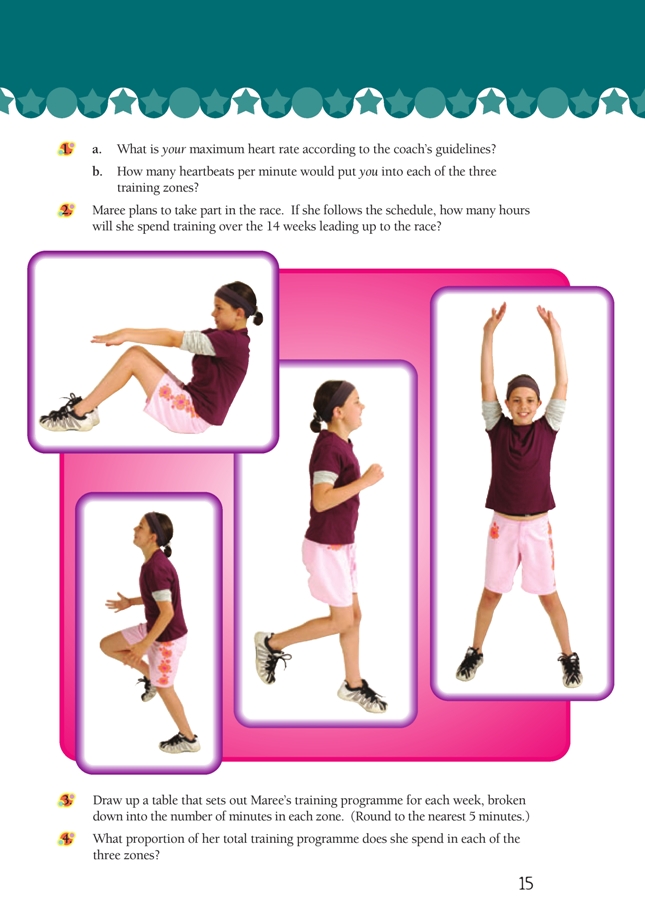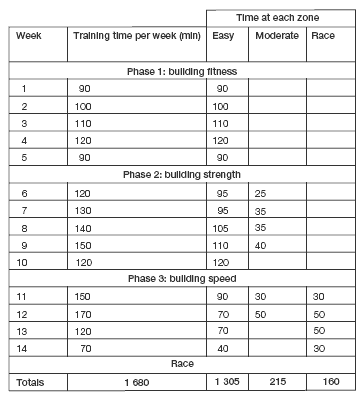This is a level 5 number activity from the Figure It Out series. It relates to Stage 8 of the Number Framework.
A PDF of the student activity is included.
Click on the image to enlarge it. Click again to close. Download PDF (1129 KB)
find percentages of whole number
Number Framework Links
Use these activities to help students consolidate their knowledge of basic facts (stage 6) and use them in conjunction with percentages (stage 7).
A calculator
This activity illustrates the way that a training programme for an endurance event is often constructed. It gives students practice at interpreting information expressed as percentages, finding a percentage of a quantity (of time), and rounding. If your students are not very familiar with percentages, you should do some pre-teaching. You will also need to make a decision on whether you want them to use calculators for the first three questions. If not, discuss with them the kinds of strategies that
they will need. If yes, make sure that they know how to enter percentages on a calculator. Even if theirs has a % key, expect them to enter percentages as decimals: 0.8 for 80%, 0.25 for 25%, 0.05 for 5%. By insisting on this, you will reinforce the understanding that the decimal and percentage forms are mathematically identical, you will be saving the students unnecessary keystrokes, and you will ensure that they are able to do percentage calculations on any calculator, not just one with a % key.
In question 1a, students work out their own maximum heart rate. This is expressed as maximum heartbeats per minute. Using the given formula, a 9-year-old’s maximum heart rate would be 220 – 9 = 211 beats/min.
Question 1b is asking for the ranges of heartbeat that apply to the student answering the question. As most of those using the activity will be 9–11 years old, here are the ranges for your reference:
For question 2, the students could either add all the minutes and then divide by 60 or convert time to hours and minutes and then add. Which method would be quicker and why? If students are not using calculators, ask them to share their strategies.
Question 3 asks students to convert the percentage amounts to their minute equivalents, rounded to the nearest 5 minutes. They should begin by drawing up a suitable table. This should be similar to the one in the student book but with the third column split into 3 so that there is a separate column for each training zone. If the information is organised in this way, it becomes very easy to answer the last question.
The calculations required for question 3 all involve user-friendly numbers, so there is no particular need for calculators. By using number strategies, students will gain experience and confidence at working with percentages and their fraction equivalents. For example: 25% of 140 is the same as 1/4 of 140. 140 = 100 + 40. 1/4 of 100 = 25 and of 40 = 10, so of 140 = 25 + 10 = 35.
Make sure that you remind students to round to the nearest 5 minutes. This is partly to keep the numbers simple, but it also reflects the fact that it is unlikely that a training programme of this kind would be organised in blocks of 19 minutes or 51 minutes (for example). When a number is exactly halfway between two 5s, it is standard practice to round up. In this situation, another number will have to be rounded down so that the total minutes remain the same. This means that the numbers
in the Answers may be up to 5 minutes different from your students’ answers, depending on the order in which they did the parts.
Question 4 asks for the proportion of time Maree will spend in each of the zones. As long as they have completed a table as suggested for question 3, all that the students need to do is put the total for each of the three zones (in turn) over the total minutes for the entire training programme, calculate the results as decimals, and interpret these as percentages. A calculator is definitely needed for these calculations.
Answers to Activity
1. a. Answers will vary. (Example: the maximum heart rate for a 10-yr-old would be
220 – 10 = 210 beats per min.)
b. Answers will vary. For a 10-yr-old, the zones would be:
Easy 126–147 beats per min
Moderate 147–168 beats per min
Race pace 168–179 beats per min
2. 28 hrs. (1 680 min ÷ 60 = 28 hrs)
3.
4. 77.7% at easy, 12.8% at moderate, 9.5% at race.



